Scientists have discovered one of the youngest exoplanets ever observed, TIDYE-1b, a gas giant located 520 light-years from Earth. This exoplanet, just 3 million years old, offers a rare opportunity to study planetary formation in its earliest stages.
TIDYE-1b orbits a protostar in the Taurus molecular cloud, which is a stellar nursery for the birth of new stars and planets. Its discovery, published in Nature on November 20, sheds new light on the rapid formation of gas giants. Unlike terrestrial planets like Earth, which form slowly, gas giants like TIDYE-1b form much more quickly, making this finding an exciting insight into the early processes of planet creation.
The planet itself is small in diameter, just about less than Jupiter and having about 40% mass from Jupiter. TIDYE-1b orbits the star in about 8.8 days, which means placing it at an extraordinary nearness to the protostar, something quite strange in a planet this young.
“This discovery gives us a glimpse into how gas giants are formed in rapid succession, unlike the much slower development of terrestrial planets,” said Madyson Barber, University of North Carolina at Chapel Hill graduate student who led the research.
Twist In The Tale
One of the most interesting things about this discovery is that the protoplanetary disk surrounding TIDYE-1b is strangely aligned. The disk that surrounds the protostar from which the planet is forming is tilted by about 60 degrees relative to the planet and its star. This goes against previous models for planetary formation, which suggest disks should be flat and in alignment.
Andrew Mann, a planetary scientist and co-author of the study, said, “A misaligned disk like this is rare because planets usually form within flat, aligned disks of gas and dust.” The team is now investigating why this misalignment occurs and how it may affect the formation of planets in the system.
Role Of Companion Star
Scientists have hypothesized that misalignment may be due to a distant companion star orbiting the protostar at an estimated distance of 635 astronomical units. Though this companion star is far away enough so that its direct effect on the system is limited, it still may contribute to the unusual orientation of the disk.
Further studies will be on whether TIDYE-1b is still building material from the disk or if it is losing its atmosphere as a result of its proximity to the protostar. These observations will thus make scientists better understand the dynamics of young, rapidly forming planets.
ALSO READ | 1.5-Million-Year-Old Footprints Reveal Two Species f Early Human Ancestors Were Neighbors in Kenya





